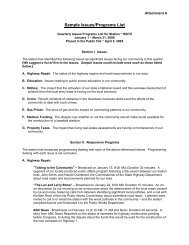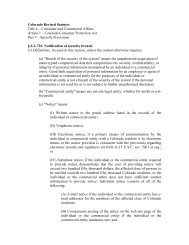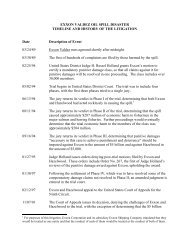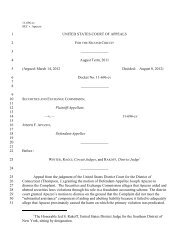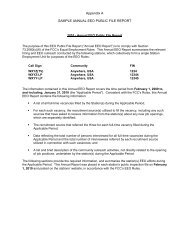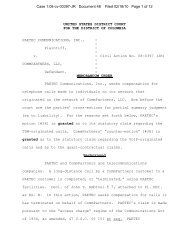QUANTA SERVICES INC, QUANTA SERVICES MANAGEMENT ...
QUANTA SERVICES INC, QUANTA SERVICES MANAGEMENT ...
QUANTA SERVICES INC, QUANTA SERVICES MANAGEMENT ...
Create successful ePaper yourself
Turn your PDF publications into a flip-book with our unique Google optimized e-Paper software.
Overall, we are optimistic about this segment’s operations in the future. We continue to believe that<br />
transmission pipeline opportunities can provide strong profitability, although these projects and the profits they<br />
generate are often subject to various risks beyond our control. We have also taken steps to diversify our<br />
operations in this segment through other services, such as pipeline integrity and gathering system opportunities,<br />
and to restructure our gas distribution operations to improve margins. We believe these measures, together with<br />
the potential in transmission pipeline opportunities, will position us for profitable growth in this segment over the<br />
long-term.<br />
Telecommunications Infrastructure Services Segment<br />
Our telecommunications services operations are seeing increasing opportunities as stimulus funding for<br />
broadband deployment to underserved areas continues to progress through the engineering phase into<br />
construction. Approximately $7.2 billion in funding has been awarded under the ARRA for numerous broadband<br />
deployment projects across the U.S. To receive funding for these projects, however, awardees are generally<br />
required to file environmental impact statements, the approval of which has delayed projects. While some of<br />
these projects are still waiting on required permits and approvals, most of the projects have received approvals<br />
and are moving forward with construction. As awardees receive their environmental impact permits and ARRA<br />
funding, projects are being rapidly deployed to meet stimulus deadlines that require completion of projects within<br />
three years, which will extend through 2013 for many projects. We anticipate this deployment schedule will<br />
increase spending for telecommunications services through 2013. We also anticipate some of our customers that<br />
received stimulus funding to continue to expand their networks even though stimulus funding may no longer be<br />
available.<br />
We expect spending to continue by our customers on fiber optic backhaul systems to provide links from<br />
wireless cell sites to broader voice, data and video networks. The substantial growth in wireless data traffic is<br />
significantly straining the capacity of traditional backhaul infrastructure. Capacity constraints, as well as the need<br />
for improved quality and reliability, are driving wireless carriers to upgrade existing backhaul systems to fiber<br />
optic backhaul systems using fiber optic cable, referred to as “fiber to the cell site” initiatives. In addition, several<br />
wireless companies have announced plans to increase their cell site deployments over the next few years,<br />
continue network enhancement initiatives and accommodate the deployment of next generation wireless<br />
technologies. In particular, the transition to 4G and LTE (long-term evolution) technology by wireless service<br />
providers will require significant modification of their networks and new cell sites. We also believe opportunities<br />
remain over the long-term as a result of fiber build-out initiatives by wireline carriers and government<br />
organizations, although we do not expect spending for these initiatives to increase significantly over the levels<br />
experienced in the past two years. We anticipate that the opportunities in both wireline and wireless businesses<br />
will increase demand for our telecommunications services over the long-term, with the timing and amount of<br />
spending from these opportunities being dependent on future economic, market and regulatory conditions and the<br />
timing of deployment of new technologies.<br />
Fiber Optic Licensing Segment<br />
Our Fiber Optic Licensing segment is experiencing growth primarily through geographic expansion, with a<br />
focus on markets where secure high-speed networks are important, such as markets where enterprises,<br />
communications carriers and educational, financial services and healthcare institutions are prevalent. We<br />
continue to see opportunities for growth both in the markets we currently serve and new markets, although we<br />
cannot predict the adverse impact, if any, of economic conditions on these growth opportunities. Our growth<br />
opportunities, however, have been affected in the education markets, which has in the past comprised a<br />
significant portion of this segment’s revenues. We believe this slowdown is due to budgetary constraints,<br />
although these constraints appear to be easing somewhat. Our Fiber Optic Licensing segment typically generates<br />
higher margins than our other operations, but we can give no assurance that the Fiber Optic Licensing segment<br />
margins will continue at historical levels. Additionally, we anticipate the need for continued capital expenditures<br />
to support the growth in this business.<br />
66




